Unit history
Attached to the U.S. Army Infantry School at Fort Benning, Georgia, the unit was authorized a strength of 27 officers and 500 enlisted men. [1] In May 1942 it was moved to Fort Bragg, North Carolina, and expanded into the 88th Glider Infantry Regiment. [2] All equipment and personnel assigned to the regiment were designed to be carried in the Waco CG-4A glider.
The regiment was stationed at Fort Meade, South Dakota, from February to November 1943. Troops were trained in infantry tactics including forced night marches, although they also had mock gliders and a tower north of the fort for practice parachute drops. The soldiers at Fort Meade were taken to Alliance, Nebraska, for their airborne training, and the glider pilots received their flight training there as well. In April 1943 the regiment was assigned to the 1st Airborne Infantry Brigade [3] along with the 507th Parachute Infantry Regiment and the 326th Glider Infantry Regiment. Both the 88th GIR and the 326th GIR were organized as two-battalion regiments.
The 88th was assigned to the 13th Airborne Division in December 1943 and moved to France in February 1945 but saw no combat. In March 1945 the 88th GIR was combined with the 326th Glider Infantry Regiment to form a three-battalion 326th Glider Infantry Regiment. [4] This was in line with the reorganization previously completed by the 17th, 82nd, and 101st Airborne Divisions. [5]
Distinctive unit insignia
A Silver color metal and enamel device 1+1⁄4 inches (3.2 cm) in height overall consisting of a shield blazoned: Azure, a cross pendal saltirewise Argent. Attached below and to the sides of the shield a Silver tripartite scroll inscribed "RIDE THE STORM" in Blue letters.
The shield is blue for Infantry. The symbol produces the effect of two crossed "8’s," which may be alluded to as canting heraldry. It also has the appearance of a propeller, indicating connection with aviation.
The distinctive unit insignia was originally approved for the 88th Infantry Airborne Battalion on 17 December 1941. It was redesignated for the 88th Infantry Regiment on 29 September 1942. The insignia was rescinded on 10 February 1959.
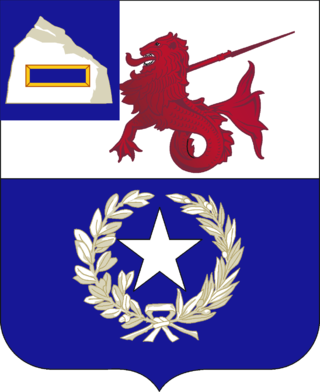
The 57th Infantry Regiment was a unit in the Philippine Scouts. During their combat in Bataan members received 1 Medal of Honor, 21 Distinguished Service Crosses and 68 Silver Stars.
The 45th Infantry Regiment was a unit of the Philippine Scouts in the Philippine Division.

The 50th Infantry Regiment is a United States Army infantry regiment.
The 304th Infantry Regiment currently consists of two battalions in the United States Army Reserve. In the current organizational plan of the U.S. Army, regimental designation is used only in historical tradition; there is no regimental commander, staff or headquarters. The 1st Battalion, 304th Regiment is headquartered in Londonderry, New Hampshire, and the 3rd Battalion, 304th Regiment is headquartered in Saco, Maine.

The 29th Field Artillery Regiment is a field artillery regiment of the United States Army, first constituted in 1918 in the National Army (USA).
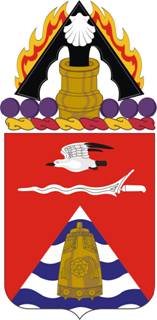
The 31st Field Artillery Regiment is a field artillery regiment of the United States Army, first Constituted in 1918 in the National Army (USA). The 1st Battalion, 31st Field Artillery, was constituted 5 July 1918 in the National Army as the 31st Field Artillery and assigned to the 11th Division. The "Proud American" Battalion was organized at Camp George G. Meade, Maryland 6 August 1918 but relieved thereafter from its assignment to the 11th Division on 30 September 1918. The unit demobilized 9 December 1918 at Camp George G. Meade, Maryland. On 22 July 1929, 31st FA was reconstituted in the Regular Army and assigned to the 2nd Division but was, once again, later relieved on 1 January 1930 from its assignment to the 2nd Division. The "Proud American" Battalion was subsequently assigned to the 7th Division on 1 July 1940 and activated at Camp Ord, California where it was reorganized and re-designated as the 31st Field Artillery Battalion on 1 October 1940. It underwent another reorganization and re-designation on 1 July 1957 as the 31st Field Artillery, "Always First," which was a parent regiment under the Combat Arms Regimental System. 31st FA was then withdrawn from the Combat Arms Regimental System 16 March 1989, reorganized under the United States Army Regimental System, and transferred to the United States Army Training and Doctrine Command (TRADOC). The unit was re-designated as the 31st Field Artillery Regiment on 1 October 2005 and began the reactivation process on 1 October 2010, attaining operational capacity under the 434th Field Artillery Brigade and activated on 11 January 2011. The "Proud American" Battalion is credited with participating in multiple campaigns in World War II and the Korean War. It has been distinguished with several decorations, to include the Philippine Presidential Unit Citation and the Republic of Korea Presidential Unit Citation that was awarded on three separate occasions.
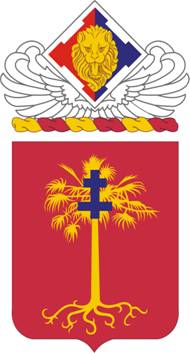
The 320th Field Artillery Regiment is a field artillery regiment of the United States Army. A parent regiment under the U.S. Army Regimental System, the 320th FAR currently has two active elements in the 101st Airborne Division : 1st Battalion, 320th FAR "Top Guns" in 2nd Brigade Combat Team; and 3rd Battalion, 320th FAR "Red Knight Rakkasans" in 3rd Brigade Combat Team. The regiment served with the 82nd Airborne Division during World Wars I and II, and regimental elements have served with the 82nd and 101st Airborne Division, the 193rd Infantry Brigade and the Berlin Brigade, and conducted combat operations in the Dominican Republic, Vietnam, Grenada, Operations Desert Shield and Storm, and the Global War on Terror.
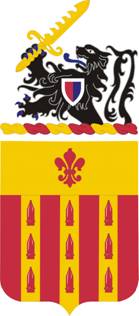
The 333rd Field Artillery Regiment is a regiment of the Field Artillery Branch of the United States Army.
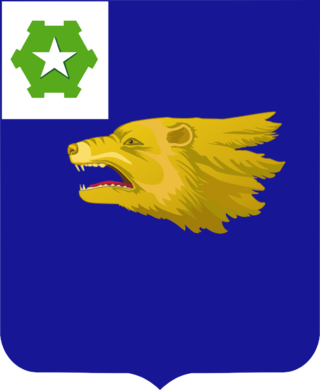
The 40th Infantry Regiment is an inactive infantry regiment in the United States Army.
The 74th Infantry Regiment was a regular infantry regiment of the United States Army. There have been two units given the title '74th Infantry Regiment'; the first was a World War I unit of the 12th Division, and the second was a World War II unit formed with US Army personnel and equipment of the inactivating US-Canadian 1st Special Service Force "Devil's Brigade". This unit was first designated as the 474th Infantry Regiment, later redesignated as the 74th Infantry Regiment.
The 213th Air Defense Artillery is a regiment in the Pennsylvania Army National Guard.

The 172nd Infantry Regiment is a Vermont Army National Guard infantry regiment which specializes in mountainous and cold weather operations. It falls under the command of the Vermont Army National Guard's 86th Infantry Brigade Combat Team (Mountain). Before the creation of the Infantry Brigade Combat Team in 2008, the regiment was recognized as the only conventional unit in the United States Army trained and equipped for mountain operations. The regiment draws heritage from the original 10th Mountain Division, which fought during World War II, both in the type of training they conduct and in the specialized equipment the unit maintains.

The 276th Engineer Battalion is an engineer battalion of the Virginia Army National Guard. Headquartered in Petersburg, Virginia, it is one of several Army National Guard units with campaign credit for the War of 1812.
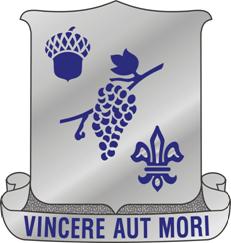
The 289th Infantry Regiment is an infantry regiment in the U.S. Army Reserve.

The 135th Infantry Regiment is an infantry regiment in the Minnesota Army National Guard.
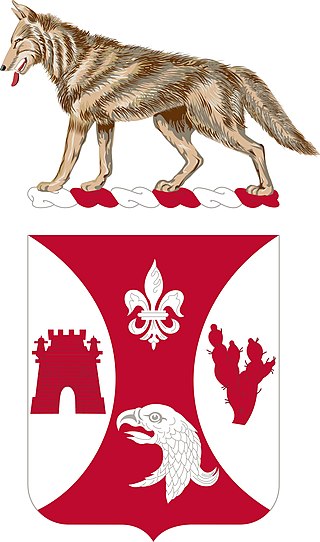
The 196th Infantry Regiment is an infantry regiment of the United States Army National Guard. It traces its lineage to units which have been both infantry and engineers.
The 340th Infantry Regiment was a National Army unit first organized for service in World War I as part of the 85th Infantry Division in Europe. Since then it has served as a training regiment, training Army Reserve and Army National Guard soldiers fighting in the War in Afghanistan (2001-2021) and the War in Iraq.

The 326th Medical Battalion was a divisional support medical unit of the United States Army. It supported the 101st Airborne Division, located at Fort Campbell, Kentucky. Its lineage and honors are perpetuated by the 626th Support Battalion, 101st Airborne Division, Fort Campbell, Kentucky.

The 326th Infantry Regiment was an infantry regiment of the United States Army that saw active service during World War I, as part of the 82nd Division and fought in the Meuse-Argonne Offensive and was inactivated in 1919. The regiment was reactivated during World War II, again as part of the 82nd Infantry Division, and was converted into a glider infantry formation, becoming the 326th Glider Infantry Regiment. Originally part of the 82nd Airborne Division, the regiment transferred to the 13th Airborne Division. However, despite training for almost three years, the 326th was never involved in any combat.
The 351st Infantry Regiment was a National Army Infantry Regiment first organized for service in World War I as part of the 88th Infantry Division in Europe. It later served in the Mediterranean Theater during World War II. Since then it has served as a training Regiment, training Army Reserve and Army National Guard Soldiers for service overseas after the September 11 terrorist attacks.


















